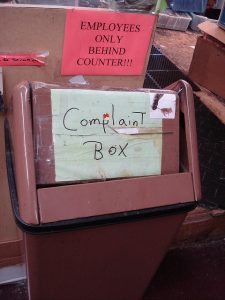
Ever feel behind the times? I just caught the current #1 song on Latin Billboard and it struck me as having two golden ingredients for a good class song:
- high student appeal and
- a couple of high frequency structures repeated.
(Though I wanted to say, Dude – she moved on, she’s happy, get over it! Ha.)
Two repeated structures in particular in this song shine with opportunities to get students talking, even students on different levels. Here are some suggestions for what to do with the song “El perdón,” a collaboration by Nicky Jam and Enrique Iglesias.
Lower novice: gripes
Invite lower novices to practice complaining – they’ll love that, right? Focus on the repeated structure from the chorus: Es que _________, dime ¿quién puede ser feliz? Esto no me gusta. ¡Esto no me gusta!
Here’s my clip of that:
I put the structure at the end. Model using your own simplified complaints, then invite those who are ready to help build a class list. See if any extroverts are willing to actually sing the line with one of the sample complaints. Finally, ask students to make their own and present (sing?) it. As an extension, create a survey or poll for students to ask and answer questions to find out what everyone’s complaining about.
It’s neither healthy nor friendly to be so negative, though, right? Tell students, okay, enough complaining – we can just as easily make this about talking about what’s going great; all we do is remove the no and replace with sí – “Es que _______, esto sí me gusta, esto SÍ me gusta!” (Got any ideas for adjusting that middle phrase?)
Higher novice / Lower intermediate:
What was happening and what is happening? Students can use this repeated structure to talk about what they were doing yesterday (Intermediate Low) and what is happening to them today (Novice High): estaba _____ando/iendo, por (un lugar) _______ando/iendo, [hoy estoy] _____ando/iendo. Something like that. You get the idea. Here’s that clip.
And now, for the unfortunate fine print…
For these two guys, the lyrics were surprisingly clean. BUT in the main part of the chorus there is a terribly unfortunate use of “como un loco tomando.” Drinking your pain away is not a message for the classroom; I left Nicky Jam’s half of the chorus out of my clip on purpose. But that doesn’t mean I’d leave it out of the discussion. Phrases like that can be a great springboard for deep and responsible thinking!
For these two guys, the video could be a lot worse, but it’s not appropriate for my classroom anyway. Among other issues: the barely clad bicyclists with the headlamps, I’ve got no idea what that’s about. If you want to play the whole song, you can easily find a different video, a performance or lyric video.
The song and video for “El perdón” are copyrighted material and the clips I made for Edpuzzle are for brief educational use only. I think all Spanish teachers should use Latin pop music in the classroom, and I also think we should all model responsible consumerism, purchasing legal music and encouraging students to do the same. I don’t agree with everything these guys do, but they work for their money.
Photo:

13 Comments
Comments are closed.



What a great idea!
I played this song (lyric version) for #maniamusical, and used the phrase “tomando como un loco” as a springboard for conversation with my upper level students. Of course, since I teach at a Christian school, I can not only ask them if drinking is legal or a correct response to pain, but what they think the Bible says about that action. It’s been good.
Great point, Kathy! I would definitely have done that in my year 3 or 4 class!
I am using so many things that I learned from you and others at Camp Musicuentos last year! I am so thankful for you.
“Products, practices, and perspectives. Products, practices, and perspectives.” That’s my refrain for my kiddos who want to snicker about videos–and principal who pretended to be shocked even at the bikini in “Darte un beso”. I’d really like to do more to analyze those but haven’t thought of a good way yet. #blogpostporfavor?
I’m well aware I have a super high filter here that puts me way in the minority (remember, I’m probably the lone holdout who will not show El internado). 😉
Did you see this blog post – Ethics in the language classroom? It’s a good summary of my approach to material that might be questionable. I’ll talk about it, a whole lot. I’m always ready for bringing students to questions that don’t have easy or comfortable answers! But as I tell them before the bottle-murder scene comes on in Pan’s Labyrinth – you just can’t un-see something.
Give me more details on your question and I’ll think about how to address it here. You mean how to analyze products, practices, perspectives?
Aha, I see you did read it – you commented on it. 🙂
Here’s a comment I loved by Martina Bex on that other post:
“I think that it is far more important to match your ethical barometer to the most innocent students rather than to the majority. Their parents have worked hard to maintain it, for whatever reason, and it would be a professional failure to the parent if I spoiled their years of hard work. I am NOT their parent, and so I must defer to the parent’s wishes for their children.”
But this is a very controversial topic. There are a great many people who don’t feel this way. I have heard some teachers say that they’re doing kids a favor by educating them in a way that their parents would disapprove of because they’re clearly preparing them better for the “real world.” Sometimes even the government perpetuates the idea that if parents aren’t meeting certain standards in their child’s information stream then they need to step in – and they get to set some pretty interesting standards. I understand the perspective, and I’m not talking about isolationism bordering on child abuse here in any sense, but as a homeschooler you can guess where I fall on that. I’m very protective of my right to determine what my children learn. 😉
[…] really liked it. Sara Elizabeth Cottrell posted some wonderful ideas for this song on her blog Musicuentos. I did something else with the song. First, we identified every word that they knew after only […]
Thank you! One of my students just recently said we needed to learn a more current song, and this is perfect.
Thank you for posting about this song! I just made this activity based on your structures and I added a cloze activity as well: https://williamsonci.files.wordpress.com/2015/04/el-perdc3b3n.pdf I would like to share it with your permission.
That looks great, Dustin! Feel free!
[…] high frequency structures. With permission from Sara-Elizabeth Cottrell of Musicuentos blog (see her blog post about this song) I have created an activity based on the high frequency structures in the song and also a cloze […]
[…] perdón” and blogged about ways to use it in both novice and intermediate classes. That post was the 5th-most popular post of […]